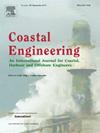评估不同海岸环境下的海岸线朝向变化
IF 4.5
2区 工程技术
Q1 ENGINEERING, CIVIL
引用次数: 0
摘要
了解和预测不同时间和空间尺度的海岸线变化对于有效的、数据驱动的海岸管理至关重要。岸线位置是海滩形态变化的可靠指标,已使用复杂的数值模型进行评估。最近,基于平衡的岸线演化模型(EBSEMs)因其在模拟岸线方向(包括跨岸和旋转(长岸)变化)方面的效率而受到关注。然而,现有的岸线旋转ebsem主要应用于微潮海滩,在不同的沿海环境中得到的验证有限。本研究评估了Jaramillo等人(2021)提出的EBSEM在模拟七个海湾海滩的海岸线旋转变动性方面的性能和可扩展性:Narrabeen海滩(澳大利亚)、Tairua海滩(新西兰)、Blackpool海滩(英国)、Poniente海滩、Llevant海滩、Cala Millor海滩和Moncofa海滩(西班牙)。这些地点在沉积物大小、潮汐状况、监测频率和数据类型方面代表了不同的环境条件。该模型在整个监测周期、高程等高线和时间分辨率下进行了测试。结果表明,EBSEM在不同海滩类型中表现良好,有效地捕获了短期和季节性海岸线轮换模式。然而,在高能量事件或人为干预的环境中,如Poniente, Llevant和Cala Millor海滩,观察到准确性降低。敏感性分析强调了时间分辨率和潮间带高程对模型性能的重要性。虽然EBSEM显示出更广泛应用的巨大潜力,但需要进一步改进以更好地捕获风暴驱动和人为变化。这些改进将增强其在沿海适应规划、减灾和面对气候变化的长期海岸线管理方面的效用。本文章由计算机程序翻译,如有差异,请以英文原文为准。
Assessing shoreline orientation variation across diverse coastal environments
Understanding and predicting shoreline variability at various temporal and spatial scales is vital for effective, data-driven coastal management. Shoreline position, a reliable indicator of beach morphological changes, has been assessed using complex numerical models. Recently, equilibrium-based shoreline evolution models (EBSEMs) have gained traction for their efficiency in simulating shoreline orientation, including cross-shore and rotational (longshore) changes. However, existing EBSEMs for shoreline rotation have been applied predominantly to microtidal beaches, with limited validation across diverse coastal environments.
This study evaluates the performance and scalability of the EBSEM proposed by Jaramillo et al. (2021) in modelling shoreline rotational variability at seven embayed beaches: Narrabeen Beach (Australia), Tairua Beach (New Zealand), Blackpool Beach (United Kingdom), Poniente Beach, Llevant Beach, Cala Millor Beach, and Moncofa Beach (Spain). These sites represent diverse environmental conditions in terms of sediment size, tidal regimes, monitoring frequency, and data types. The model was tested across full monitoring periods, elevation contours, and temporal resolutions.
Results show that EBSEM performs well across contrasting beach types, effectively capturing short-term and seasonal shoreline rotation patterns. However, reduced accuracy was observed in environments with high-energy events or human interventions, such as Poniente, Llevant, and Cala Millor beaches. Sensitivity analyses highlight the importance of temporal resolution and intertidal elevation in model performance.
While the EBSEM shows significant potential for broader application, further refinement is needed to better capture storm-driven and anthropogenic variability. These improvements would enhance its utility for coastal adaptation planning, hazard mitigation, and long-term shoreline management in the face of climate change.
求助全文
通过发布文献求助,成功后即可免费获取论文全文。
去求助
来源期刊

Coastal Engineering
工程技术-工程:大洋
CiteScore
9.20
自引率
13.60%
发文量
0
审稿时长
3.5 months
期刊介绍:
Coastal Engineering is an international medium for coastal engineers and scientists. Combining practical applications with modern technological and scientific approaches, such as mathematical and numerical modelling, laboratory and field observations and experiments, it publishes fundamental studies as well as case studies on the following aspects of coastal, harbour and offshore engineering: waves, currents and sediment transport; coastal, estuarine and offshore morphology; technical and functional design of coastal and harbour structures; morphological and environmental impact of coastal, harbour and offshore structures.
 求助内容:
求助内容: 应助结果提醒方式:
应助结果提醒方式:


